Most of the signs you see on New Zealand roads are international symbolic signs. This means they use the same shapes and symbols as traffic signs all over the world.
Symbolic signs are used because they are quick to read and easy for all drivers to understand.
New Zealand’s signs are generally made of reflective material, making them easier to read at night.
The signs on our roads can be divided into three types:
You must be able to recognise and understand each type of sign.
Some examples of these signs, particularly related to heavy vehicles, are shown on below.
Note: the examples shown are only a small sample of the symbolic signs used on New Zealand’s roads. They are intended to familiarise you with the three main types of symbolic sign rather than introduce you to all of the signs you will see when driving.
Compulsory signs tell you what you must or must not do.
They are usually red or blue.

Turn right |
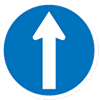
Keep going straight ahead |
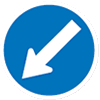
Keep left |

Five minute loading zone sign for goods vehicles |

Parking for buses only, no time limit |
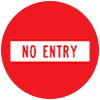
You must not drive into this road |
ImportantRoad authorities (for example, local councils) may have special rules for road users in specific areas. These restrictions should be indicated by signs or markings. |
Some compulsory signs have red borders.

You must not turn left |
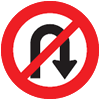
You must not make a U-turn |
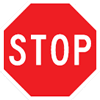
You must stop and then give way |

Heavy vehicles prohibited (not allowed) on a section of road |

This is the road classification sign for a Class C road. Heavy vehicles can drive on this road only to deliver or collect goods or passengers along the road |

The red bordered compulsory sign tells you that you have a clearance under these cables of 4.6 metres Note: this sign can apply to all vehicles, not just heavy vehicles |

You must keep left unless passing |
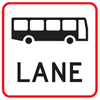
Bus lane that can also be used by cycles, motorcycles, mopeds |

Maximum length for a heavy vehicle is 9.2 metres |
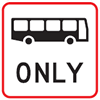
Bus lane that can only be used by buses |

Transit lane, which can only be used by passenger service vehicles, cycles, motorcycles, mopeds and vehicles carrying at least the number of people displayed on the sign (eg T2 means two or more people, T3 means three or more people) |

Heavy vehicle bridge limits (eg maximum axle and gross vehicle weights and maximum speed limit apply) |
Warning signs alert you to a particular hazard on the road ahead. They warn you to be careful for your own safety, the safety of other road users or the safety of road workers carrying out maintenance.
There are two types of warning signs:
Both types of sign are usually diamond shaped.
Permanent warning signs are yellow and black.
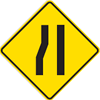
Road narrows |

This warning sign advises trucks to use a low gear to keep the vehicle under control (when going downhill). |
|

This warning sign lets you know that if you are driving a heavy (or high-sided) vehicle, it could tip over as you drive around a curve. You need to keep your speed to 65km/h or less to be safe. |

The yellow warning sign lets you know there are electric cables overhead |

Two permanent warning signs combined – narrow bridge with warning for wide vehicles |
Temporary warning signs are orange and black.
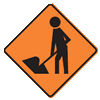 Roadworks Roadworks |
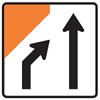 Left lane closed Left lane closed |
 Slips Slips |
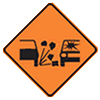 Gravel surface Gravel surface |
 Stop on request Stop on request |
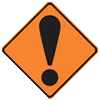 Note: this sign will always be displayed with another sign explaining the hazard, eg ‘Flooding’
|
ImportantBetween 2006 and 2012, 569 trucks rolled over. |
Information signs give you useful information, for example, the distance to the next town. They are all rectangular, but come in a range of different colours and sizes.
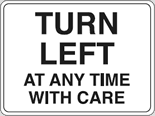 You may turn left, but first give way to any pedestrians and vehicles You may turn left, but first give way to any pedestrians and vehicles |
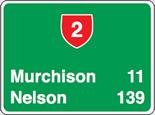 Shows the state highway number and the distance in kilometres to places listed Shows the state highway number and the distance in kilometres to places listed |
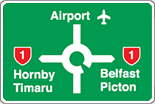 Shows directions to places at the next intersection Shows directions to places at the next intersection |
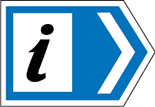 Shows the way to the nearest information centre Shows the way to the nearest information centre |
|
|
 This information sign, usually seen in urban areas, indicates a town/city centre by pass This information sign, usually seen in urban areas, indicates a town/city centre by pass |
 This information sign is also found in urban areas and asks you to minimise noise by not using engine brakes This information sign is also found in urban areas and asks you to minimise noise by not using engine brakes |
 Temporary information sign – roadworks or construction site access 100 metres ahead Temporary information sign – roadworks or construction site access 100 metres ahead |